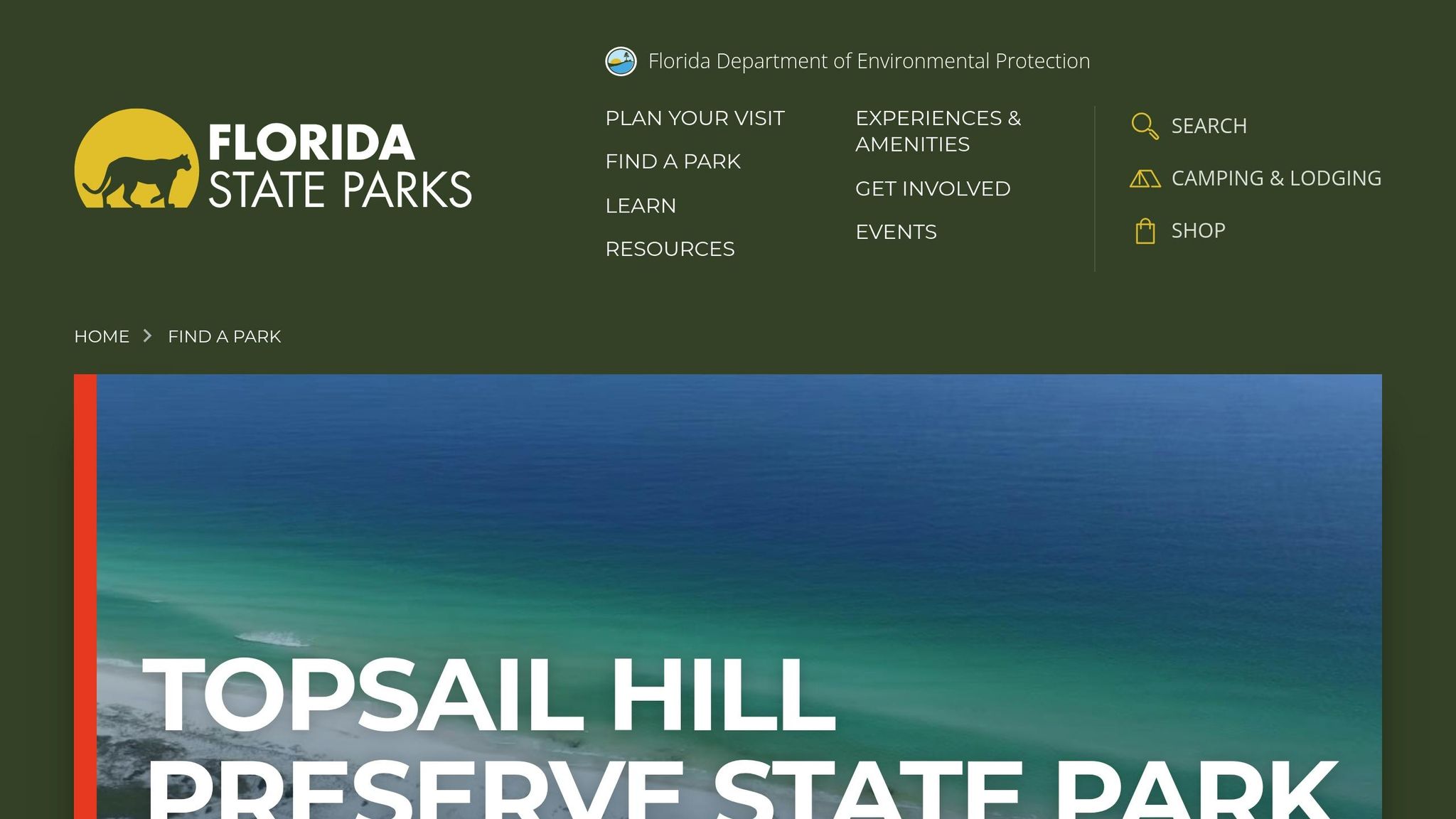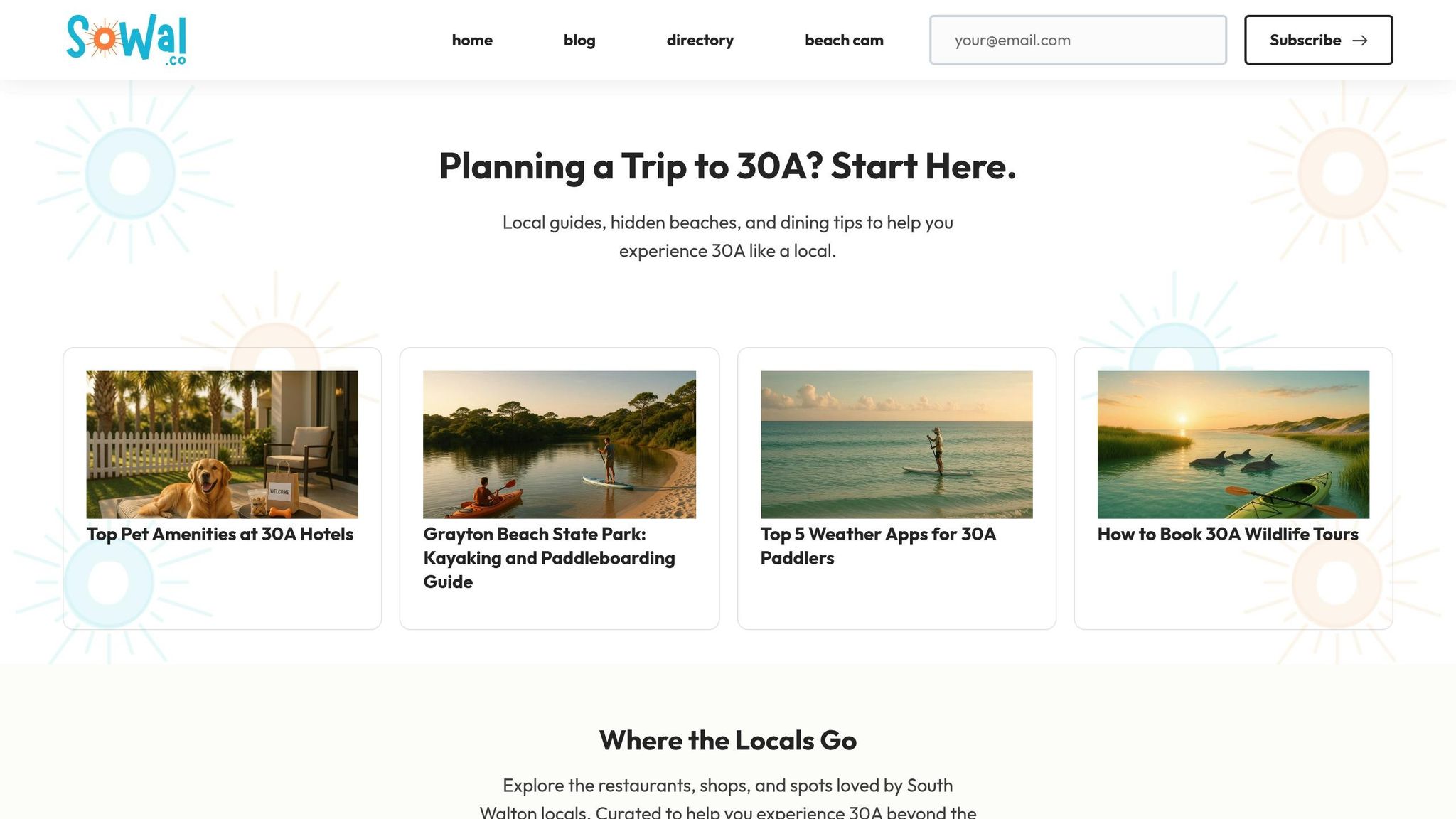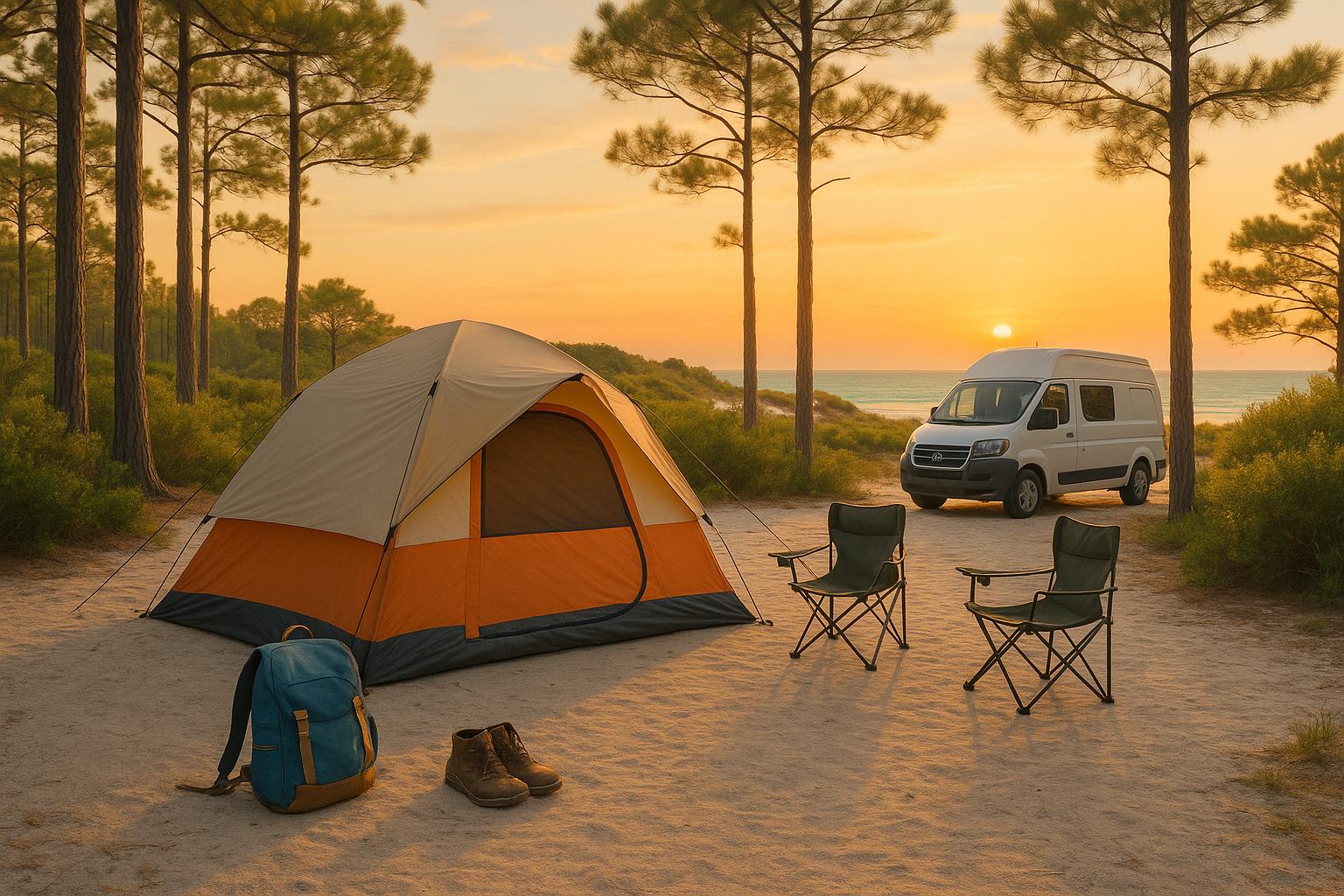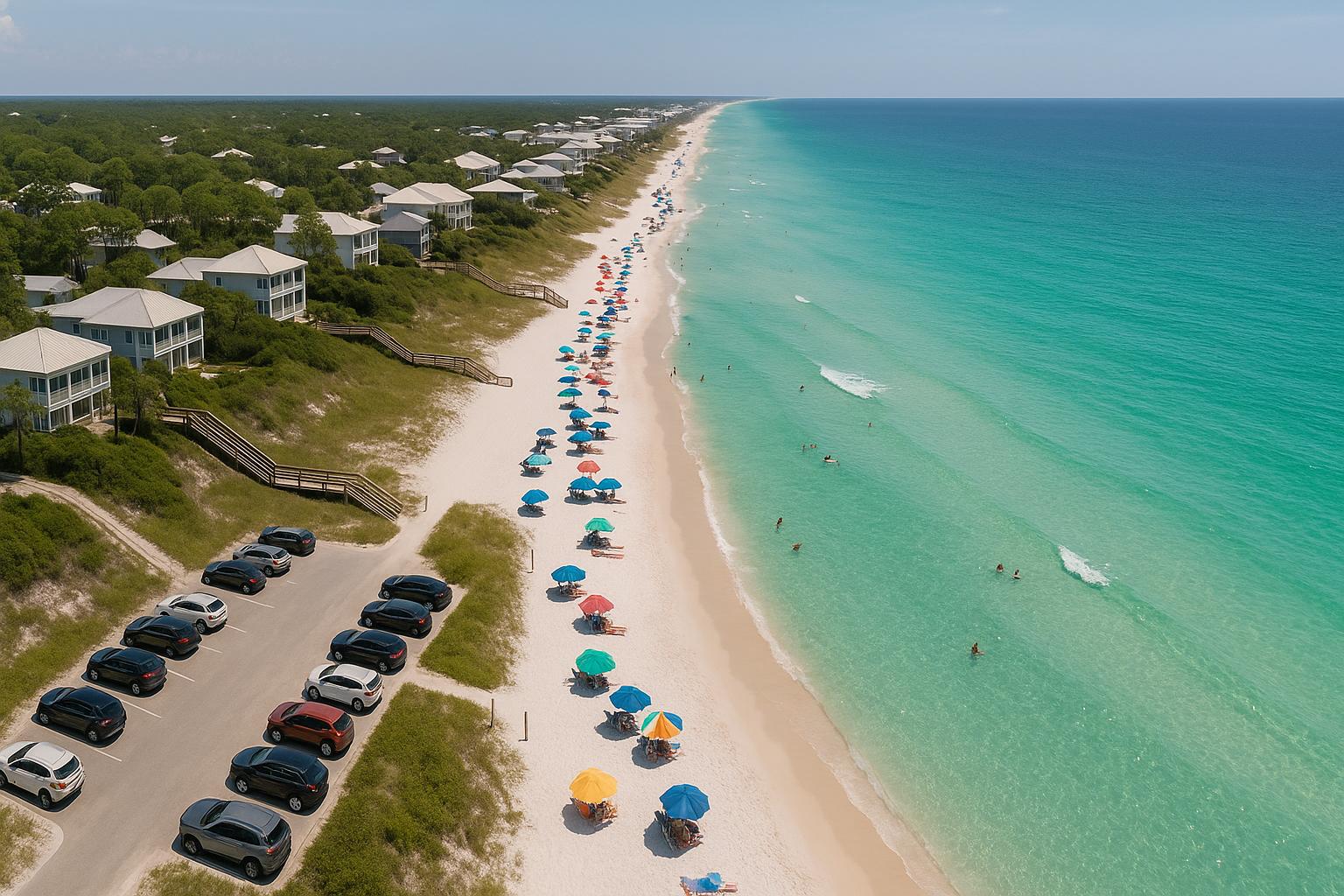Want to explore the scenic trails of 30A state parks? Here's how to make the most of your day:
- Choose the Right Park: From the forest trails of Point Washington to the coastal views at Deer Lake, each park offers something different. Match the trail to your fitness level and interests.
- Pack Smart: Bring sturdy shoes, water (at least 2 liters per person), sunscreen, snacks, and a first-aid kit. Lightweight, moisture-wicking clothing is key for Florida's climate.
- Check Conditions: Review weather forecasts and park updates for closures or safety alerts. Cell service can be spotty, so download maps in advance.
- Stay Safe: Stick to marked trails, carry a whistle, and be mindful of wildlife. Share your plans with someone before heading out.
- Respect Nature: Leave no trash, stay on trails, and give wildlife plenty of space.
Whether you're a beginner or an experienced hiker, 30A's parks offer trails for everyone. With proper preparation, you'll enjoy stunning views, unique ecosystems, and a peaceful escape into nature.
Topsail Hill Preserve State Park in Santa Rosa Beach, Florida. Beach, Bike Trails, Campground, Lakes

How to Choose the Right State Park and Trail
Picking the perfect state park and trail is all about matching your preferences and fitness level. The 30A region offers a variety of ecosystems, from serene coastal dune lakes to lush forests, so it's worth considering what kind of scenery and experience you’re after. Each park along 30A has something distinct to offer, whether you’re looking for sandy trails, peaceful boardwalks, or expansive hiking paths.
30A State Parks Overview
The 30A area is home to four key state parks, each with its own unique trail system. Understanding what sets them apart can help you decide which one best suits your adventure.
Topsail Hill Preserve State Park is known for its 10+ miles of trails that wind through quartz dunes and old-growth pine forests. The Campbell Lake Nature Trail, a 5.2-mile paved path, is perfect for families and casual hikers. For those seeking more of a challenge, the Morris Lake Trail offers a 4.6-mile loop with mixed terrain, including sandy sections.
Point Washington State Forest boasts the largest trail network in the area, with over 27 miles of trails spread across 15,000 acres. The Eastern Lake Trail system offers three color-coded loops: yellow (3.5 miles), red (5.9 miles), and orange (10.5 miles). These trails let you adjust your hike based on how much time and energy you have. Along the way, you’ll traverse pine flatwoods, sandhills, and wetlands, with chances to spot deer, osprey, and even bald eagles.
Grayton Beach State Park provides a more intimate hiking experience with about 4 miles of trails. These easy-to-moderate paths wind through pine flatwoods and scrub, giving access to Western Lake and the hidden "Prayer of the Woods" spot beneath a canopy of dunes. This park is ideal for those who enjoy coastal landscapes.
Deer Lake State Park offers shorter boardwalks and a 1.5-mile nature trail. The boardwalks cross pristine dunes, offering stunning views while protecting the fragile environment. This park is a haven for wildlife enthusiasts, with opportunities to see the endangered beach mouse.
| Park | Trail Length | Difficulty | Key Features |
|---|---|---|---|
| Topsail Hill Preserve | 4.6–5.2 miles (key trails) | Easy to Moderate | Quartz dunes, coastal lakes, paved paths |
| Point Washington State Forest | 3.5–10.5 miles (loops) | Easy to Moderate | Pine forests, wetlands, wildlife |
| Grayton Beach State Park | ~4 miles | Easy to Moderate | Dune lakes, pine flatwoods, hidden spots |
| Deer Lake State Park | 1.5 miles + boardwalks | Easy | Pristine dunes, coastal ecosystems |
What to Consider When Picking a Trail
When choosing a trail, think about your fitness level, available time, and the type of scenery you want to explore. If you're hiking with family or are new to hiking, easier trails like Deer Lake’s boardwalks or Grayton Beach’s shorter paths are great options. These trails provide a manageable introduction to the area’s natural beauty without requiring a major time commitment.
For moderate hikers, Topsail Hill’s Campbell Lake Trail offers a paved route that minimizes fatigue, while Point Washington’s shorter loops provide a chance to explore forest ecosystems without overexertion. These trails strike a balance between accessibility and adventure.
Experienced hikers looking for a challenge can tackle the sandy sections of the Morris Lake Trail at Topsail Hill or the full 10.5-mile Eastern Lake loop in Point Washington. These longer, more rugged trails demand preparation but reward you with solitude and a deeper connection to the wilderness.
Your choice of trail can also depend on the scenery you want to experience. If coastal dune lakes are your priority, Topsail Hill and Grayton Beach are excellent picks. For those who love forests and diverse ecosystems, Point Washington delivers with its mix of wetlands and pine flatwoods. And if you’re drawn to beach access, Deer Lake offers a seamless blend of hiking and shoreline exploration.
Don’t forget to factor in your group’s stamina and the time you have available. Shorter loops are ideal for families or beginners, while longer trails are better for seasoned hikers. If you’re planning other activities like beach visits or dining along 30A, choose a trail that fits your schedule.
Where to Get Trail Information
For the most accurate and up-to-date trail information, start with the official Florida State Parks websites. These sites provide detailed trail maps, difficulty ratings, and updates on closures or maintenance. It’s a good idea to download maps before your visit, as cell service can be spotty in remote areas.
Park entrance stations are another great resource. They typically offer printed trail guides and display maps with current conditions. Park rangers can also share helpful advice, such as recent wildlife sightings or trail recommendations tailored to your interests.
For a local perspective, check out sowal.co. This digital guide is packed with practical tips from fellow hikers, seasonal advice, and insights on hidden gems that might not appear on official maps.
Before heading out, consult multiple sources to ensure you’re prepared, especially during summer when heat or storms can impact trail conditions. Combining official park data with local insights will help you make the most of your hike. With your trail picked and conditions checked, you’re ready to gear up and hit the path.
Gear and Preparation for Your 30A Day Hike
Having the right gear can make all the difference when exploring the 30A state parks. The sandy trails, coastal humidity, and unique ecosystems demand thoughtful preparation to keep your hike both safe and enjoyable.
Essential Gear for Your Hike
Navigating sandy, uneven trails calls for sturdy hiking shoes with solid traction. Pair them with moisture-wicking socks to avoid blisters on longer treks. For clothing, skip cotton - it gets heavy and uncomfortable in Florida’s humid climate. Instead, opt for synthetic or merino wool shirts that wick moisture effectively. A light jacket is also a smart addition to guard against coastal winds and sudden temperature dips.
Don’t underestimate Florida’s sun. Pack a wide-brimmed hat, polarized sunglasses, and sunscreen with at least SPF 30. Even on overcast days, UV rays can be intense.
Stay hydrated by carrying at least 2 liters of water per person. Hydration packs or reusable bottles work well since many trails lack water refill stations. To keep your energy up, bring snacks like granola bars, trail mix, dried fruit, or nut butter packets.
Use a comfortable backpack with padded straps and multiple compartments to distribute your load evenly. Download digital maps ahead of time, but also bring a paper backup in case cell service is unreliable.
A basic first-aid kit is a must. Stock it with adhesive bandages, antiseptic wipes, pain relievers, and any personal medications. Tweezers and medical tape can also come in handy for minor injuries.
Lastly, pack a fully charged phone and a portable battery pack. These are essential for emergencies, GPS navigation, and, of course, snapping photos of the stunning scenery.
Seasonal Hiking Tips for 30A
Florida’s weather varies by season, and so should your preparation.
- Summer: Temperatures often climb into the 80s and 90s°F, with high humidity. Start your hike early, ideally before 9:00 AM, to avoid peak heat. Carry extra water, take frequent breaks in shaded areas, and wear lightweight, breathable clothing. Reapply SPF 50+ sunscreen every two hours to protect your skin.
- Winter: Temperatures can swing from the 40s to the 70s°F in a single day. Dress in layers: a moisture-wicking base, an insulating middle layer, and a windproof outer shell. Coastal winds can make it feel much colder, so pack a warm hat and gloves for extra comfort.
- Spring and Fall: These seasons offer milder weather but can be unpredictable. Sudden afternoon thunderstorms are common, so pack a lightweight rain jacket. The cooler mornings and evenings make layering a good idea.
Adjust your gear and timing based on the season for a more enjoyable experience.
Pre-Hike Preparation Steps
Before hitting the trails, take these important steps to ensure a smooth adventure:
- Check the weather: Look at the forecast within 24 hours of your hike. Florida weather can change quickly, especially in summer when afternoon storms are frequent. Pay attention to temperature ranges, humidity levels, wind conditions, and rain chances.
- Share your plans: Let someone know your itinerary, including the park, trail, and your expected return time. This simple precaution can be a lifesaver in case of an emergency.
- Study the trail map: Familiarize yourself with key landmarks, trail junctions, and emergency exit points. Take note of ranger station locations and emergency contact numbers.
- Check for park updates: Visit official Florida State Parks websites for alerts about trail closures, wildlife activity, or weather-related issues. Some parks also provide wildlife sighting updates to help you prepare for potential encounters.
- Pack insect repellent: Be ready for mosquitoes, ticks, and other insects. Also, know how to handle encounters with local wildlife, such as snakes or alligators near water.
For more tips on gear and local conditions, check out sowal.co. This digital guide offers practical advice from fellow hikers and seasonal insights to supplement official park resources.
Once you’ve packed your gear and completed your preparations, you’ll be ready to explore 30A’s trails with confidence and comfort.
sbb-itb-d06eda6
Safety Tips and Trail Rules
Exploring the state parks along 30A can be a rewarding experience, but staying safe and respecting the environment are key to ensuring an enjoyable outing. These parks are home to unique ecosystems and wildlife, so practicing good safety habits helps protect both visitors and nature.
How to Stay Safe on Trails
- Stick to designated trails. Wandering off can damage fragile ecosystems and increase the risk of getting lost.
- Always carry a cell phone and be familiar with the park's emergency contacts. If you lose your way, try retracing your steps using landmarks. If you're still disoriented, stay put and wait for help.
- Be cautious around wildlife. Maintain a safe distance from animals, and if you encounter a bear, make noise, back away slowly, and never run.
- Watch out for coastal hazards. Heat exhaustion is a common summertime risk; symptoms like dizziness, nausea, or excessive sweating shouldn't be ignored. Uneven surfaces such as soft sand, exposed roots, or slippery boardwalks can also lead to falls.
- Near water, keep an eye out for reptiles and insects. Ticks are common in wooded areas, so check yourself thoroughly after your hike.
- Bring a whistle and stick to your planned route. Florida's afternoon thunderstorms can develop quickly - if the weather turns dangerous, find shelter and wait it out.
By following these precautions, you can minimize risks and focus on enjoying the natural beauty around you.
Proper Trail Behavior
Safety goes hand in hand with good trail etiquette, which helps protect the environment and ensures a positive experience for everyone.
- Follow Leave No Trace principles. Pack out all trash, even food scraps, and avoid disturbing plants or natural features. This helps preserve the habitat and keeps the park pristine.
- Be mindful of other trail users. Yield to uphill hikers, bikers, or horseback riders on shared paths, and keep noise levels low to maintain the tranquility of the area.
- Respect wildlife habitats. For example, at Deer Lake State Park, endangered beach mice rely on protected dune ecosystems. Stay on designated paths or boardwalks to avoid disturbing these sensitive areas.
- If pets are allowed, keep them leashed and check park rules before bringing them along.
- Follow all posted regulations about fires, camping, and restricted areas. Some zones may be temporarily closed for habitat restoration or wildlife protection.
- Show courtesy to fellow hikers. Greet others politely, step off the trail if you need a break, and make sure there's enough space for everyone to pass.
- Observe quiet zones and respect areas where educational programs or guided tours are taking place.
For more tips and seasonal advice to enhance your 30A hiking experience, visit sowal.co. It’s a helpful resource for staying informed and making the most of your day outdoors.
Local Resources to Improve Your Hike
Preparing for a hike is about more than just packing snacks and lacing up your boots. The right resources can turn an ordinary outing into a memorable adventure. In the 30A region, you’ll find plenty of tools to help you plan your day on the trails, offering a mix of official updates and local tips. By blending these two sources, you can stay informed and uncover hidden gems that might otherwise go unnoticed.
Using sowal.co for Trip Planning

If you're looking to explore South Walton's 30A coastline like a local, sowal.co is your go-to digital guide. This platform doesn’t just provide trail information - it paints a full picture of the region’s outdoor opportunities, helping you plan a day that goes beyond the hike itself.
For starters, sowal.co highlights state parks known for their stunning white-sand beaches, rare dune lakes, and picturesque nature trails. Each park’s unique features are broken down, making it easier to decide where to go. But the site doesn’t stop there. It also points out nearby dining spots, local events, and secluded beaches, helping you turn a few hours on the trail into an all-day adventure.
What really sets sowal.co apart is its community-driven content. You’ll find updates on volunteer opportunities, trail cleanup events, and guided nature walks. Seasonal activities like outdoor yoga sessions, festivals, and educational programs near state parks are also featured, giving you the chance to mix hiking with other local experiences.
Practical details are covered, too. From parking availability and park fees to tips on the best times to visit specific trails, sowal.co fills in the gaps that official websites might miss. Want to know where to spot wildlife or find a scenic viewpoint that’s off the beaten path? This site has you covered. While it excels at offering local insights, pairing it with official park websites ensures you’re fully prepared for any surprises.
Checking Park Websites for Updates
For the most up-to-date and reliable information, the official Florida State Parks websites are a must-visit. These sites provide real-time updates on trail conditions, safety alerts, and operational changes, especially during peak seasons or emergencies.
Before heading out, check the website of the park you plan to visit. For example, Grayton Beach State Park’s official site shares alerts about trail maintenance, wildlife activity, and temporary closures. Topsail Hill Preserve State Park keeps visitors informed about water levels, fire restrictions, and seasonal access changes that might impact your plans.
During hurricane season or after heavy rains, these websites can update multiple times a day, offering critical information about trail safety. They also provide essential logistical details like entrance fees, operating hours, and permit requirements. Downloadable maps with GPS coordinates for trailheads are particularly helpful in areas with limited cell service.
Some parks even announce special programs exclusively on their official platforms. For instance, Camp Helen State Park regularly posts about ranger-led hikes and educational tours - activities that can add depth to your visit. Seasonal advisories about local wildlife, which could affect trail accessibility or safety, are another key feature.
Conclusion: Get the Most from Your 30A Day Hike
Planning a memorable day hike in 30A's state parks comes down to three key factors: solid preparation, staying safe, and respecting the environment. With the right gear, local insights, and a commitment to preserving nature, you'll see why these coastal trails are celebrated for their stunning views and abundant wildlife. These principles make every step on 30A's trails more rewarding.
Preparation starts with choosing a trail that matches your experience level and packing the essentials. Whether you prefer a leisurely boardwalk stroll or a more demanding forest trek, 30A's parks offer something for everyone. By following the safety tips mentioned earlier, you can focus on enjoying the breathtaking scenery around you.
Caring for the environment is just as important. Coastal dune lakes, pine flatwoods, and other unique ecosystems thrive when hikers respect the land. Simple actions like sticking to marked trails, packing out your trash, and giving wildlife space go a long way in protecting these habitats. The push for sustainable hiking reflects a growing understanding that recreation and conservation go hand in hand.
In 2023, a local hiking group hosted a guided hike at Grayton Beach State Park to promote environmental education and Leave No Trace practices. Led by park rangers, the event included a nature walk and a trail cleanup, removing over 50 pounds of litter. Participants left with a deeper appreciation for the park's natural beauty and the importance of preserving it. (Source: 30A.com, 2023)
Your hiking experience doesn't end with the trails. Pairing local resources like sowal.co for insider tips with official park websites for updates ensures you make the most of your visit. Starting early helps you avoid crowds, beat the heat, and increases your chances of spotting wildlife in its natural setting.
Keep in mind, your entry fees directly support park upkeep and conservation efforts. Every dollar helps protect species like the white-topped pitcher plant and gopher tortoise. By hiking responsibly and contributing to these efforts, you're playing a part in preserving 30A's natural beauty for future generations of outdoor enthusiasts.
FAQs
How can I stay safe while hiking in 30A state parks, especially when dealing with wildlife and changing weather?
Staying safe while hiking in 30A state parks requires some planning and a good dose of common sense. Start by checking the weather forecast - sudden storms or scorching temperatures can sneak up on you. Dress in layers, opt for moisture-wicking fabrics, and pack enough water to stay hydrated throughout your hike.
Wildlife is part of the charm, but it’s crucial to respect their space. Keep a safe distance from all animals, and never offer them food. Pay close attention to where you step - snakes and other critters can be found along the trails. Stick to marked paths, and if you do come across a potentially dangerous animal, stay calm and retreat slowly.
For navigation, bring a map or use a trustworthy GPS app, and make sure someone knows your hiking plans before you set off. With these precautions, you’ll be ready to enjoy the natural beauty of 30A's state parks safely.
How do I choose the best 30A state park trail for my fitness level and interest in nature?
When choosing the ideal trail in 30A state parks, think about your fitness level and how much time you can dedicate to your hike. Trails come in all shapes and sizes - some are short and easy, perfect for beginners, while others are longer and more demanding, catering to seasoned hikers. Take a look at park maps and trail descriptions to get a sense of elevation changes and distances before you head out.
If you’re drawn to specific ecosystems like coastal dunes, wetlands, or pine forests, it’s worth researching which parks showcase these natural wonders. For instance, Grayton Beach State Park is famous for its breathtaking dune lakes, while Topsail Hill Preserve State Park boasts a mix of diverse habitats. A little planning goes a long way in ensuring your hike aligns with both your interests and abilities.
What should I pack for a day hike in 30A's state parks, considering the local climate and terrain?
When getting ready for a day hike in 30A's state parks, it's crucial to pack with the area's warm, humid climate and sandy trails in mind. Start with lightweight, moisture-wicking clothes to stay cool and dry, and wear sturdy hiking shoes that can handle sandy or uneven paths. Add a hat, sunglasses, and sunscreen to shield yourself from the sun.
Make sure to bring plenty of water - at least 2 liters per person - and pack some high-energy snacks like granola bars or trail mix to keep your energy up. A small backpack is perfect for carrying essentials like a map, a fully charged phone, insect repellent, and a basic first-aid kit. If you're planning to explore less-traveled trails, a compass or GPS device can be a helpful addition for navigation.
Lastly, check the weather forecast before heading out, as conditions can change quickly. With the right preparation, you'll be set to enjoy everything 30A's state parks have to offer - safely and comfortably!



